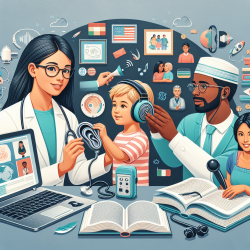Introduction
In the ever-evolving field of speech-language pathology, integrating novel methods and technologies is crucial for enhancing client outcomes. One such innovation is the use of audio-video (AV) food journaling for dietary assessment. This method, validated in a recent study, presents a promising alternative to traditional food journaling techniques. By understanding and implementing the findings of this research, practitioners can improve their skills and provide more accurate dietary assessments for their clients.
The Study: An Overview
The research article titled An Assessment of the Validity of an Audio-Video Method of Food Journaling for Dietary Quantity and Quality explores the efficacy of AV food journaling in a free-living setting. Conducted in a university cafeteria, the study involved participants recording their meals using an iPod Touch, capturing both video and audio descriptions of their food selections. The recorded data was then compared to direct, weighed food assessments to evaluate accuracy.
Key Findings
- High Correlation: The study found a high correlation between nutrient values recorded using the AV method and those obtained through direct weighing, except for Vitamin E and total weight.
- Reduced Participant Burden: Unlike traditional methods, the AV approach minimizes participant burden by eliminating the need for written records.
- Improved Accuracy: The AV method provides a valid alternative for estimating food intake, offering a practical solution for real-world dietary assessments.
Implications for Practitioners
For practitioners in speech-language pathology and related fields, the adoption of AV food journaling can significantly enhance dietary assessments. Here are some ways to integrate this method into your practice:
- Training and Implementation: Educate clients on using AV technology for food journaling. Provide tutorials and support to ensure accurate recordings.
- Data Analysis: Utilize nutrition software to analyze AV recordings, allowing for detailed insights into clients' dietary habits.
- Client Engagement: Encourage clients to actively participate in their dietary assessments, fostering a collaborative approach to nutrition management.
Encouraging Further Research
While the study provides a strong foundation for the use of AV food journaling, further research is needed to explore its application in diverse settings and populations. Practitioners are encouraged to contribute to this growing body of knowledge by conducting their own studies and sharing findings with the community.
Conclusion
Incorporating AV food journaling into your practice can revolutionize dietary assessments, offering a more accurate and client-friendly approach. By staying informed and embracing new technologies, practitioners can continue to provide exceptional care and support for their clients.
To read the original research paper, please follow this link: An Assessment of the Validity of an Audio-Video Method of Food Journaling for Dietary Quantity and Quality.










